Woolworths CEO Bradford Banducci: Leadership Style and Impact Analysis
VerifiedAdded on 2023/01/17
|10
|2792
|43
Report
AI Summary
This report provides a comprehensive analysis of Bradford Banducci's leadership as CEO of Woolworths. It delves into his use of transformational leadership, highlighting its relevance and impact on the organization's performance. The report examines the challenges Banducci faced and the lessons learned from his leadership style, including his customer-focused approach. Furthermore, it explores motivational theories, such as Maslow's hierarchy of needs and Herzberg's two-factor theory, as applied by Outback Steakhouse. The report also analyzes team dynamics, characteristics, norms, and conflict-solving techniques within a student task group. It concludes with team development strategies, emphasizing the importance of common goals, commitment, and effective communication. The report provides valuable insights into leadership, management, and team effectiveness.
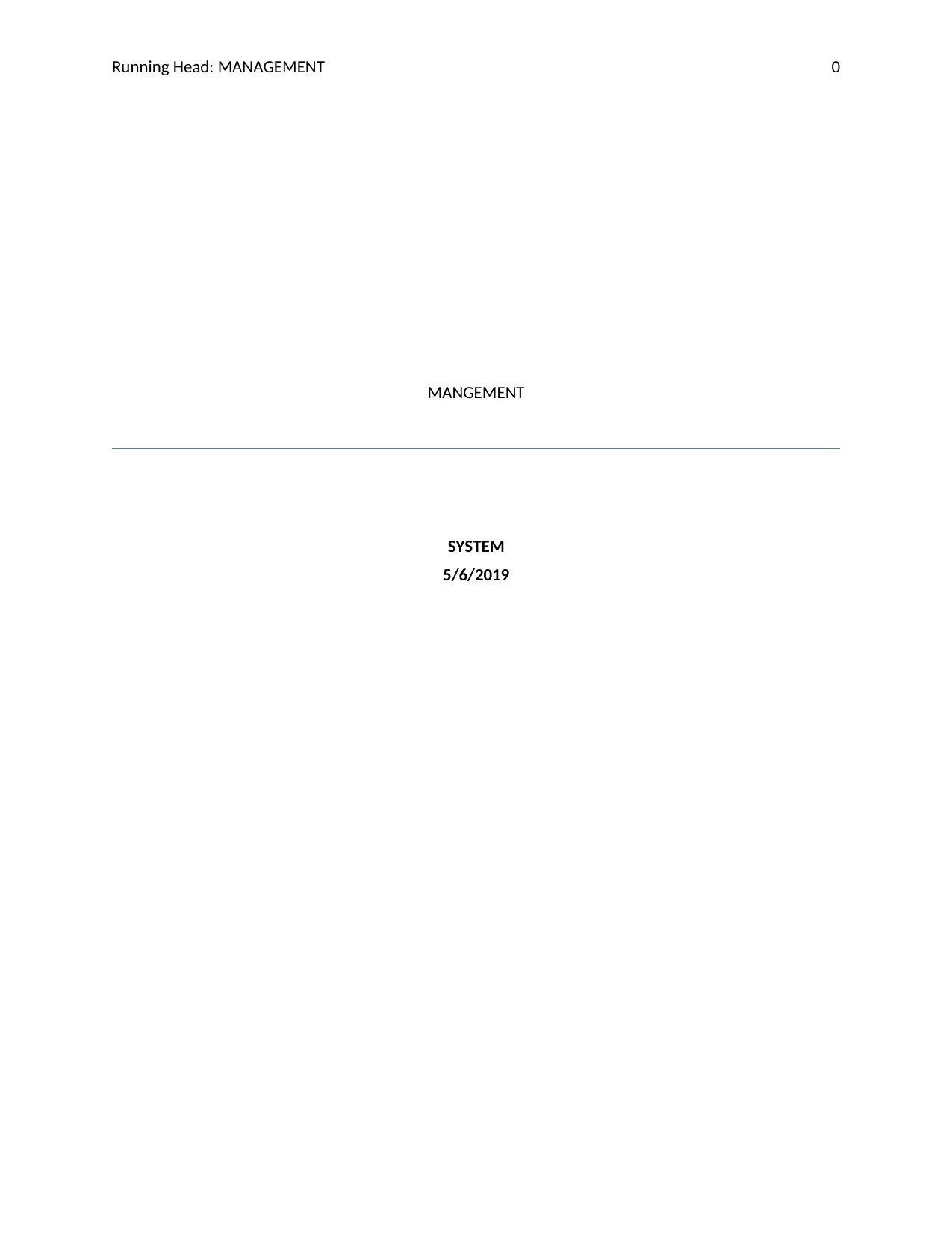
Running Head: MANAGEMENT 0
MANGEMENT
SYSTEM
5/6/2019
MANGEMENT
SYSTEM
5/6/2019
Paraphrase This Document
Need a fresh take? Get an instant paraphrase of this document with our AI Paraphraser
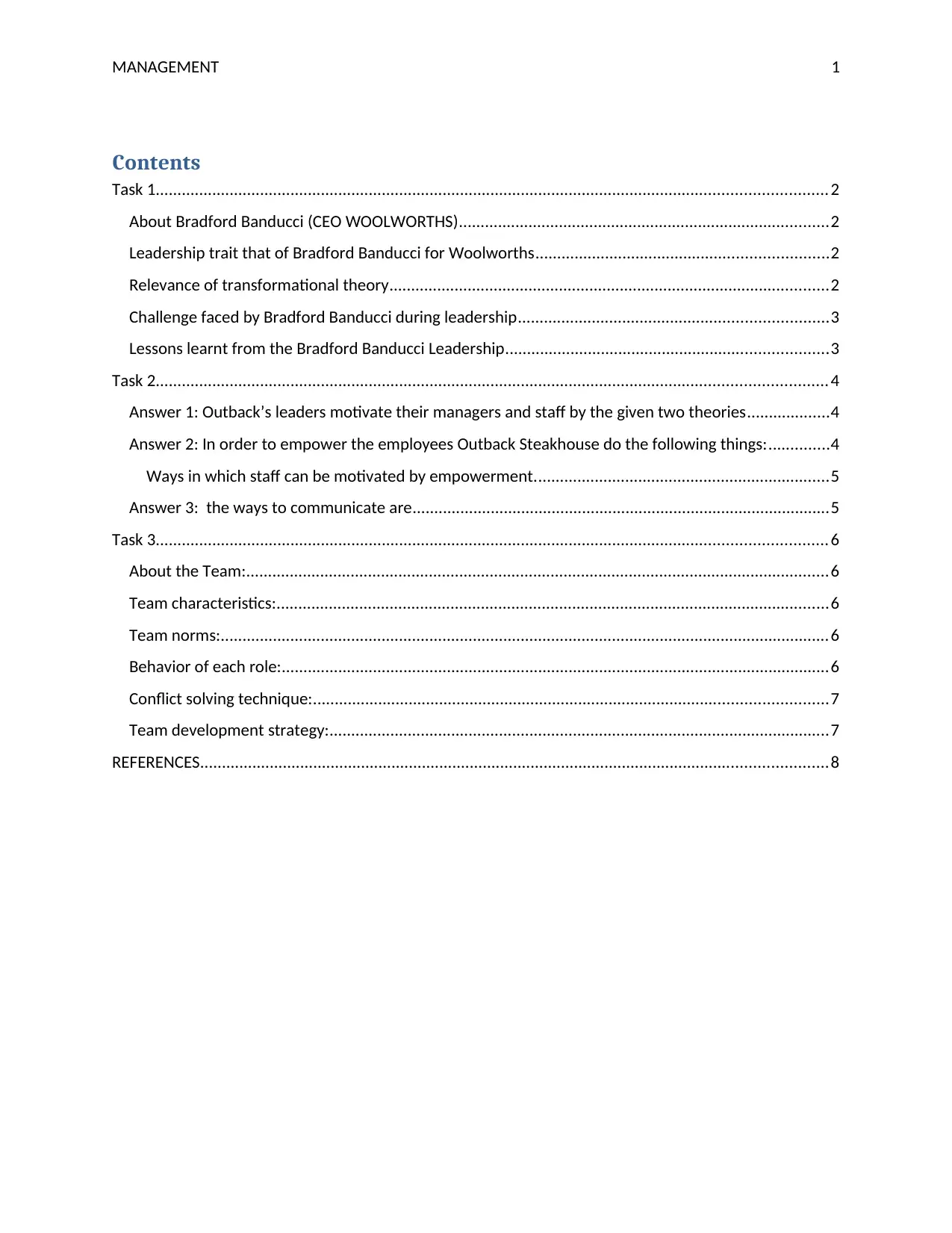
MANAGEMENT 1
Contents
Task 1..........................................................................................................................................................2
About Bradford Banducci (CEO WOOLWORTHS).....................................................................................2
Leadership trait that of Bradford Banducci for Woolworths...................................................................2
Relevance of transformational theory.....................................................................................................2
Challenge faced by Bradford Banducci during leadership.......................................................................3
Lessons learnt from the Bradford Banducci Leadership..........................................................................3
Task 2..........................................................................................................................................................4
Answer 1: Outback’s leaders motivate their managers and staff by the given two theories...................4
Answer 2: In order to empower the employees Outback Steakhouse do the following things:..............4
Ways in which staff can be motivated by empowerment....................................................................5
Answer 3: the ways to communicate are................................................................................................5
Task 3..........................................................................................................................................................6
About the Team:......................................................................................................................................6
Team characteristics:...............................................................................................................................6
Team norms:............................................................................................................................................6
Behavior of each role:..............................................................................................................................6
Conflict solving technique:......................................................................................................................7
Team development strategy:...................................................................................................................7
REFERENCES................................................................................................................................................8
Contents
Task 1..........................................................................................................................................................2
About Bradford Banducci (CEO WOOLWORTHS).....................................................................................2
Leadership trait that of Bradford Banducci for Woolworths...................................................................2
Relevance of transformational theory.....................................................................................................2
Challenge faced by Bradford Banducci during leadership.......................................................................3
Lessons learnt from the Bradford Banducci Leadership..........................................................................3
Task 2..........................................................................................................................................................4
Answer 1: Outback’s leaders motivate their managers and staff by the given two theories...................4
Answer 2: In order to empower the employees Outback Steakhouse do the following things:..............4
Ways in which staff can be motivated by empowerment....................................................................5
Answer 3: the ways to communicate are................................................................................................5
Task 3..........................................................................................................................................................6
About the Team:......................................................................................................................................6
Team characteristics:...............................................................................................................................6
Team norms:............................................................................................................................................6
Behavior of each role:..............................................................................................................................6
Conflict solving technique:......................................................................................................................7
Team development strategy:...................................................................................................................7
REFERENCES................................................................................................................................................8
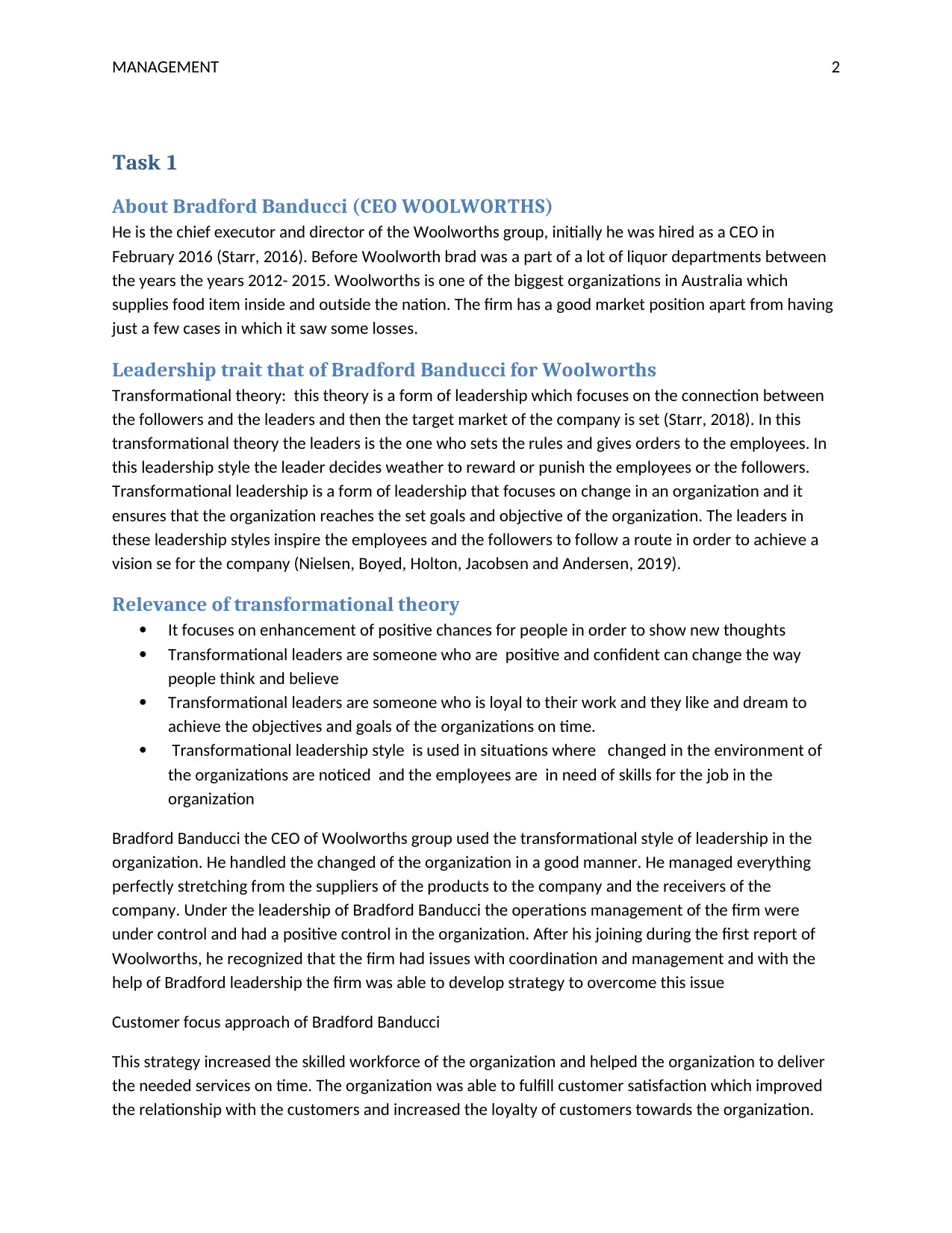
MANAGEMENT 2
Task 1
About Bradford Banducci (CEO WOOLWORTHS)
He is the chief executor and director of the Woolworths group, initially he was hired as a CEO in
February 2016 (Starr, 2016). Before Woolworth brad was a part of a lot of liquor departments between
the years the years 2012- 2015. Woolworths is one of the biggest organizations in Australia which
supplies food item inside and outside the nation. The firm has a good market position apart from having
just a few cases in which it saw some losses.
Leadership trait that of Bradford Banducci for Woolworths
Transformational theory: this theory is a form of leadership which focuses on the connection between
the followers and the leaders and then the target market of the company is set (Starr, 2018). In this
transformational theory the leaders is the one who sets the rules and gives orders to the employees. In
this leadership style the leader decides weather to reward or punish the employees or the followers.
Transformational leadership is a form of leadership that focuses on change in an organization and it
ensures that the organization reaches the set goals and objective of the organization. The leaders in
these leadership styles inspire the employees and the followers to follow a route in order to achieve a
vision se for the company (Nielsen, Boyed, Holton, Jacobsen and Andersen, 2019).
Relevance of transformational theory
It focuses on enhancement of positive chances for people in order to show new thoughts
Transformational leaders are someone who are positive and confident can change the way
people think and believe
Transformational leaders are someone who is loyal to their work and they like and dream to
achieve the objectives and goals of the organizations on time.
Transformational leadership style is used in situations where changed in the environment of
the organizations are noticed and the employees are in need of skills for the job in the
organization
Bradford Banducci the CEO of Woolworths group used the transformational style of leadership in the
organization. He handled the changed of the organization in a good manner. He managed everything
perfectly stretching from the suppliers of the products to the company and the receivers of the
company. Under the leadership of Bradford Banducci the operations management of the firm were
under control and had a positive control in the organization. After his joining during the first report of
Woolworths, he recognized that the firm had issues with coordination and management and with the
help of Bradford leadership the firm was able to develop strategy to overcome this issue
Customer focus approach of Bradford Banducci
This strategy increased the skilled workforce of the organization and helped the organization to deliver
the needed services on time. The organization was able to fulfill customer satisfaction which improved
the relationship with the customers and increased the loyalty of customers towards the organization.
Task 1
About Bradford Banducci (CEO WOOLWORTHS)
He is the chief executor and director of the Woolworths group, initially he was hired as a CEO in
February 2016 (Starr, 2016). Before Woolworth brad was a part of a lot of liquor departments between
the years the years 2012- 2015. Woolworths is one of the biggest organizations in Australia which
supplies food item inside and outside the nation. The firm has a good market position apart from having
just a few cases in which it saw some losses.
Leadership trait that of Bradford Banducci for Woolworths
Transformational theory: this theory is a form of leadership which focuses on the connection between
the followers and the leaders and then the target market of the company is set (Starr, 2018). In this
transformational theory the leaders is the one who sets the rules and gives orders to the employees. In
this leadership style the leader decides weather to reward or punish the employees or the followers.
Transformational leadership is a form of leadership that focuses on change in an organization and it
ensures that the organization reaches the set goals and objective of the organization. The leaders in
these leadership styles inspire the employees and the followers to follow a route in order to achieve a
vision se for the company (Nielsen, Boyed, Holton, Jacobsen and Andersen, 2019).
Relevance of transformational theory
It focuses on enhancement of positive chances for people in order to show new thoughts
Transformational leaders are someone who are positive and confident can change the way
people think and believe
Transformational leaders are someone who is loyal to their work and they like and dream to
achieve the objectives and goals of the organizations on time.
Transformational leadership style is used in situations where changed in the environment of
the organizations are noticed and the employees are in need of skills for the job in the
organization
Bradford Banducci the CEO of Woolworths group used the transformational style of leadership in the
organization. He handled the changed of the organization in a good manner. He managed everything
perfectly stretching from the suppliers of the products to the company and the receivers of the
company. Under the leadership of Bradford Banducci the operations management of the firm were
under control and had a positive control in the organization. After his joining during the first report of
Woolworths, he recognized that the firm had issues with coordination and management and with the
help of Bradford leadership the firm was able to develop strategy to overcome this issue
Customer focus approach of Bradford Banducci
This strategy increased the skilled workforce of the organization and helped the organization to deliver
the needed services on time. The organization was able to fulfill customer satisfaction which improved
the relationship with the customers and increased the loyalty of customers towards the organization.
⊘ This is a preview!⊘
Do you want full access?
Subscribe today to unlock all pages.

Trusted by 1+ million students worldwide
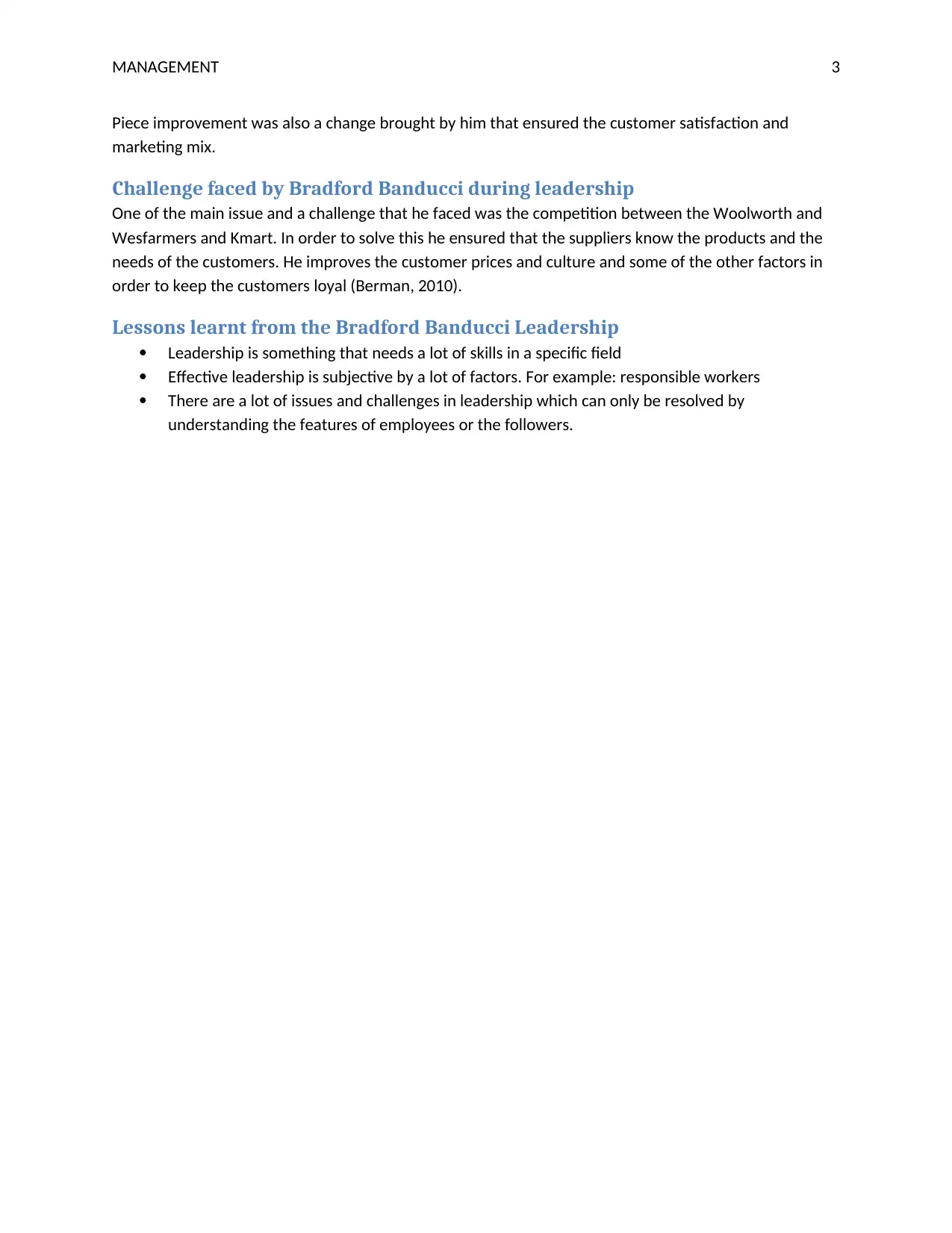
MANAGEMENT 3
Piece improvement was also a change brought by him that ensured the customer satisfaction and
marketing mix.
Challenge faced by Bradford Banducci during leadership
One of the main issue and a challenge that he faced was the competition between the Woolworth and
Wesfarmers and Kmart. In order to solve this he ensured that the suppliers know the products and the
needs of the customers. He improves the customer prices and culture and some of the other factors in
order to keep the customers loyal (Berman, 2010).
Lessons learnt from the Bradford Banducci Leadership
Leadership is something that needs a lot of skills in a specific field
Effective leadership is subjective by a lot of factors. For example: responsible workers
There are a lot of issues and challenges in leadership which can only be resolved by
understanding the features of employees or the followers.
Piece improvement was also a change brought by him that ensured the customer satisfaction and
marketing mix.
Challenge faced by Bradford Banducci during leadership
One of the main issue and a challenge that he faced was the competition between the Woolworth and
Wesfarmers and Kmart. In order to solve this he ensured that the suppliers know the products and the
needs of the customers. He improves the customer prices and culture and some of the other factors in
order to keep the customers loyal (Berman, 2010).
Lessons learnt from the Bradford Banducci Leadership
Leadership is something that needs a lot of skills in a specific field
Effective leadership is subjective by a lot of factors. For example: responsible workers
There are a lot of issues and challenges in leadership which can only be resolved by
understanding the features of employees or the followers.
Paraphrase This Document
Need a fresh take? Get an instant paraphrase of this document with our AI Paraphraser
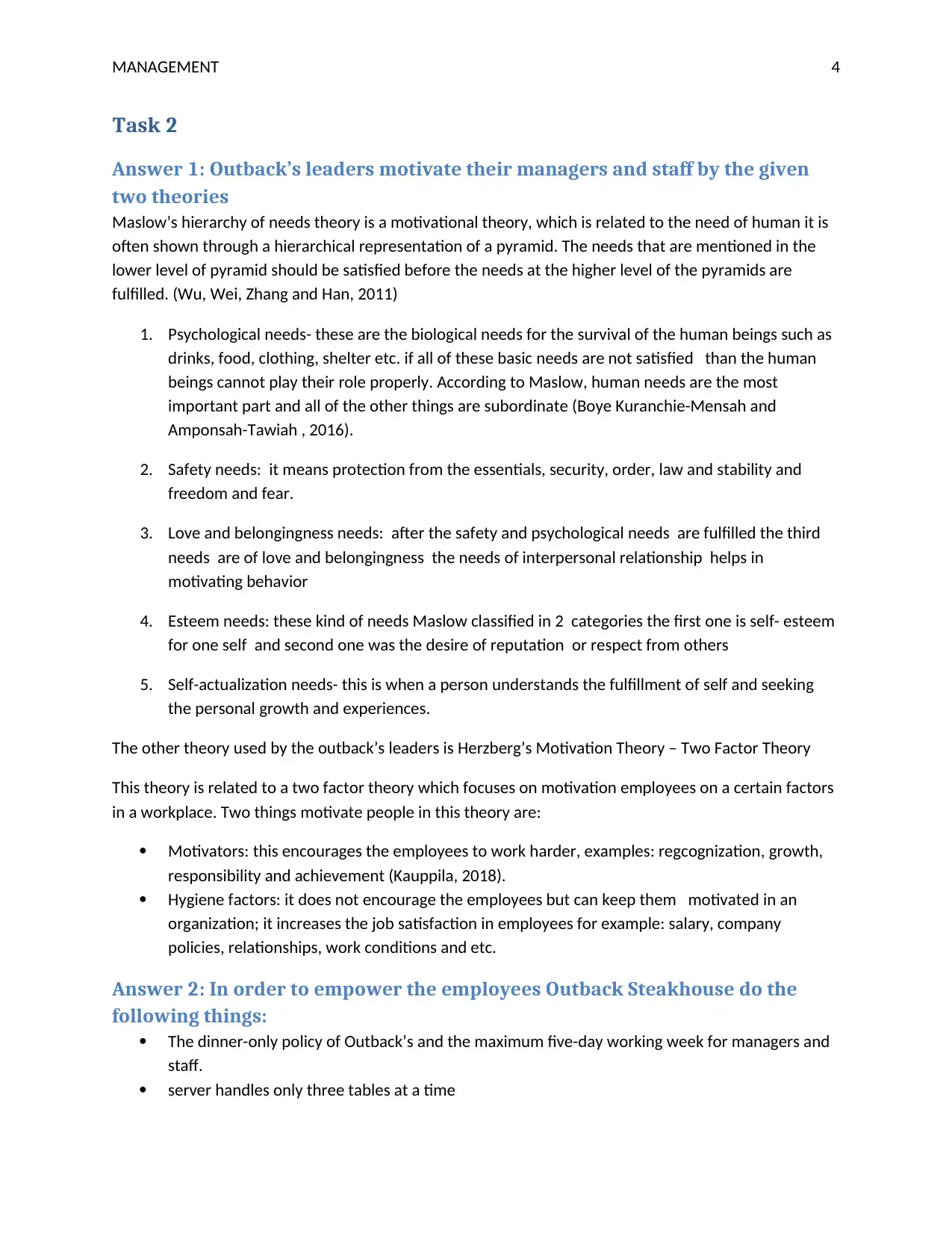
MANAGEMENT 4
Task 2
Answer 1: Outback’s leaders motivate their managers and staff by the given
two theories
Maslow’s hierarchy of needs theory is a motivational theory, which is related to the need of human it is
often shown through a hierarchical representation of a pyramid. The needs that are mentioned in the
lower level of pyramid should be satisfied before the needs at the higher level of the pyramids are
fulfilled. (Wu, Wei, Zhang and Han, 2011)
1. Psychological needs- these are the biological needs for the survival of the human beings such as
drinks, food, clothing, shelter etc. if all of these basic needs are not satisfied than the human
beings cannot play their role properly. According to Maslow, human needs are the most
important part and all of the other things are subordinate (Boye Kuranchie-Mensah and
Amponsah-Tawiah , 2016).
2. Safety needs: it means protection from the essentials, security, order, law and stability and
freedom and fear.
3. Love and belongingness needs: after the safety and psychological needs are fulfilled the third
needs are of love and belongingness the needs of interpersonal relationship helps in
motivating behavior
4. Esteem needs: these kind of needs Maslow classified in 2 categories the first one is self- esteem
for one self and second one was the desire of reputation or respect from others
5. Self-actualization needs- this is when a person understands the fulfillment of self and seeking
the personal growth and experiences.
The other theory used by the outback’s leaders is Herzberg’s Motivation Theory – Two Factor Theory
This theory is related to a two factor theory which focuses on motivation employees on a certain factors
in a workplace. Two things motivate people in this theory are:
Motivators: this encourages the employees to work harder, examples: regcognization, growth,
responsibility and achievement (Kauppila, 2018).
Hygiene factors: it does not encourage the employees but can keep them motivated in an
organization; it increases the job satisfaction in employees for example: salary, company
policies, relationships, work conditions and etc.
Answer 2: In order to empower the employees Outback Steakhouse do the
following things:
The dinner-only policy of Outback’s and the maximum five-day working week for managers and
staff.
server handles only three tables at a time
Task 2
Answer 1: Outback’s leaders motivate their managers and staff by the given
two theories
Maslow’s hierarchy of needs theory is a motivational theory, which is related to the need of human it is
often shown through a hierarchical representation of a pyramid. The needs that are mentioned in the
lower level of pyramid should be satisfied before the needs at the higher level of the pyramids are
fulfilled. (Wu, Wei, Zhang and Han, 2011)
1. Psychological needs- these are the biological needs for the survival of the human beings such as
drinks, food, clothing, shelter etc. if all of these basic needs are not satisfied than the human
beings cannot play their role properly. According to Maslow, human needs are the most
important part and all of the other things are subordinate (Boye Kuranchie-Mensah and
Amponsah-Tawiah , 2016).
2. Safety needs: it means protection from the essentials, security, order, law and stability and
freedom and fear.
3. Love and belongingness needs: after the safety and psychological needs are fulfilled the third
needs are of love and belongingness the needs of interpersonal relationship helps in
motivating behavior
4. Esteem needs: these kind of needs Maslow classified in 2 categories the first one is self- esteem
for one self and second one was the desire of reputation or respect from others
5. Self-actualization needs- this is when a person understands the fulfillment of self and seeking
the personal growth and experiences.
The other theory used by the outback’s leaders is Herzberg’s Motivation Theory – Two Factor Theory
This theory is related to a two factor theory which focuses on motivation employees on a certain factors
in a workplace. Two things motivate people in this theory are:
Motivators: this encourages the employees to work harder, examples: regcognization, growth,
responsibility and achievement (Kauppila, 2018).
Hygiene factors: it does not encourage the employees but can keep them motivated in an
organization; it increases the job satisfaction in employees for example: salary, company
policies, relationships, work conditions and etc.
Answer 2: In order to empower the employees Outback Steakhouse do the
following things:
The dinner-only policy of Outback’s and the maximum five-day working week for managers and
staff.
server handles only three tables at a time
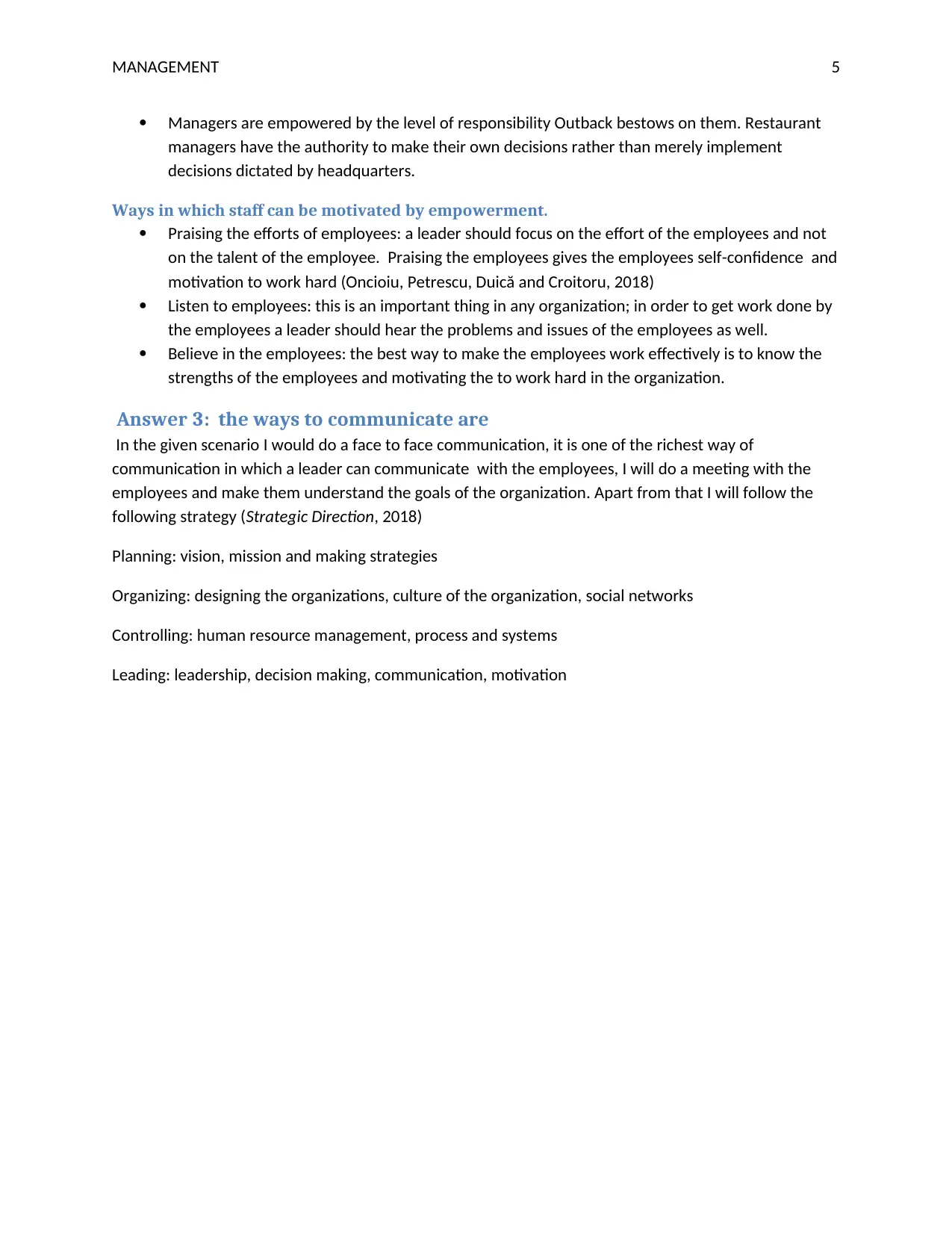
MANAGEMENT 5
Managers are empowered by the level of responsibility Outback bestows on them. Restaurant
managers have the authority to make their own decisions rather than merely implement
decisions dictated by headquarters.
Ways in which staff can be motivated by empowerment.
Praising the efforts of employees: a leader should focus on the effort of the employees and not
on the talent of the employee. Praising the employees gives the employees self-confidence and
motivation to work hard (Oncioiu, Petrescu, Duică and Croitoru, 2018)
Listen to employees: this is an important thing in any organization; in order to get work done by
the employees a leader should hear the problems and issues of the employees as well.
Believe in the employees: the best way to make the employees work effectively is to know the
strengths of the employees and motivating the to work hard in the organization.
Answer 3: the ways to communicate are
In the given scenario I would do a face to face communication, it is one of the richest way of
communication in which a leader can communicate with the employees, I will do a meeting with the
employees and make them understand the goals of the organization. Apart from that I will follow the
following strategy (Strategic Direction, 2018)
Planning: vision, mission and making strategies
Organizing: designing the organizations, culture of the organization, social networks
Controlling: human resource management, process and systems
Leading: leadership, decision making, communication, motivation
Managers are empowered by the level of responsibility Outback bestows on them. Restaurant
managers have the authority to make their own decisions rather than merely implement
decisions dictated by headquarters.
Ways in which staff can be motivated by empowerment.
Praising the efforts of employees: a leader should focus on the effort of the employees and not
on the talent of the employee. Praising the employees gives the employees self-confidence and
motivation to work hard (Oncioiu, Petrescu, Duică and Croitoru, 2018)
Listen to employees: this is an important thing in any organization; in order to get work done by
the employees a leader should hear the problems and issues of the employees as well.
Believe in the employees: the best way to make the employees work effectively is to know the
strengths of the employees and motivating the to work hard in the organization.
Answer 3: the ways to communicate are
In the given scenario I would do a face to face communication, it is one of the richest way of
communication in which a leader can communicate with the employees, I will do a meeting with the
employees and make them understand the goals of the organization. Apart from that I will follow the
following strategy (Strategic Direction, 2018)
Planning: vision, mission and making strategies
Organizing: designing the organizations, culture of the organization, social networks
Controlling: human resource management, process and systems
Leading: leadership, decision making, communication, motivation
⊘ This is a preview!⊘
Do you want full access?
Subscribe today to unlock all pages.

Trusted by 1+ million students worldwide
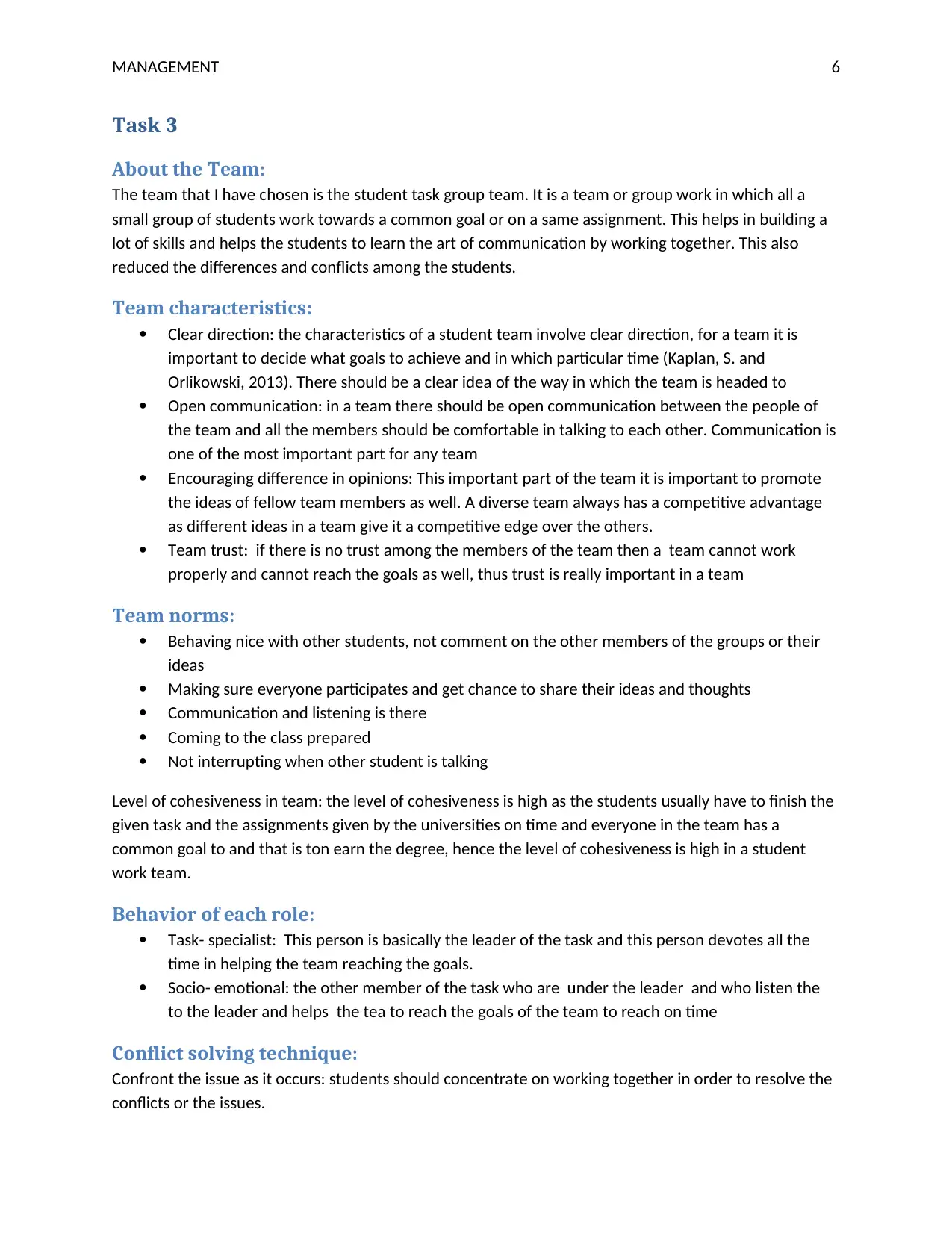
MANAGEMENT 6
Task 3
About the Team:
The team that I have chosen is the student task group team. It is a team or group work in which all a
small group of students work towards a common goal or on a same assignment. This helps in building a
lot of skills and helps the students to learn the art of communication by working together. This also
reduced the differences and conflicts among the students.
Team characteristics:
Clear direction: the characteristics of a student team involve clear direction, for a team it is
important to decide what goals to achieve and in which particular time (Kaplan, S. and
Orlikowski, 2013). There should be a clear idea of the way in which the team is headed to
Open communication: in a team there should be open communication between the people of
the team and all the members should be comfortable in talking to each other. Communication is
one of the most important part for any team
Encouraging difference in opinions: This important part of the team it is important to promote
the ideas of fellow team members as well. A diverse team always has a competitive advantage
as different ideas in a team give it a competitive edge over the others.
Team trust: if there is no trust among the members of the team then a team cannot work
properly and cannot reach the goals as well, thus trust is really important in a team
Team norms:
Behaving nice with other students, not comment on the other members of the groups or their
ideas
Making sure everyone participates and get chance to share their ideas and thoughts
Communication and listening is there
Coming to the class prepared
Not interrupting when other student is talking
Level of cohesiveness in team: the level of cohesiveness is high as the students usually have to finish the
given task and the assignments given by the universities on time and everyone in the team has a
common goal to and that is ton earn the degree, hence the level of cohesiveness is high in a student
work team.
Behavior of each role:
Task- specialist: This person is basically the leader of the task and this person devotes all the
time in helping the team reaching the goals.
Socio- emotional: the other member of the task who are under the leader and who listen the
to the leader and helps the tea to reach the goals of the team to reach on time
Conflict solving technique:
Confront the issue as it occurs: students should concentrate on working together in order to resolve the
conflicts or the issues.
Task 3
About the Team:
The team that I have chosen is the student task group team. It is a team or group work in which all a
small group of students work towards a common goal or on a same assignment. This helps in building a
lot of skills and helps the students to learn the art of communication by working together. This also
reduced the differences and conflicts among the students.
Team characteristics:
Clear direction: the characteristics of a student team involve clear direction, for a team it is
important to decide what goals to achieve and in which particular time (Kaplan, S. and
Orlikowski, 2013). There should be a clear idea of the way in which the team is headed to
Open communication: in a team there should be open communication between the people of
the team and all the members should be comfortable in talking to each other. Communication is
one of the most important part for any team
Encouraging difference in opinions: This important part of the team it is important to promote
the ideas of fellow team members as well. A diverse team always has a competitive advantage
as different ideas in a team give it a competitive edge over the others.
Team trust: if there is no trust among the members of the team then a team cannot work
properly and cannot reach the goals as well, thus trust is really important in a team
Team norms:
Behaving nice with other students, not comment on the other members of the groups or their
ideas
Making sure everyone participates and get chance to share their ideas and thoughts
Communication and listening is there
Coming to the class prepared
Not interrupting when other student is talking
Level of cohesiveness in team: the level of cohesiveness is high as the students usually have to finish the
given task and the assignments given by the universities on time and everyone in the team has a
common goal to and that is ton earn the degree, hence the level of cohesiveness is high in a student
work team.
Behavior of each role:
Task- specialist: This person is basically the leader of the task and this person devotes all the
time in helping the team reaching the goals.
Socio- emotional: the other member of the task who are under the leader and who listen the
to the leader and helps the tea to reach the goals of the team to reach on time
Conflict solving technique:
Confront the issue as it occurs: students should concentrate on working together in order to resolve the
conflicts or the issues.
Paraphrase This Document
Need a fresh take? Get an instant paraphrase of this document with our AI Paraphraser
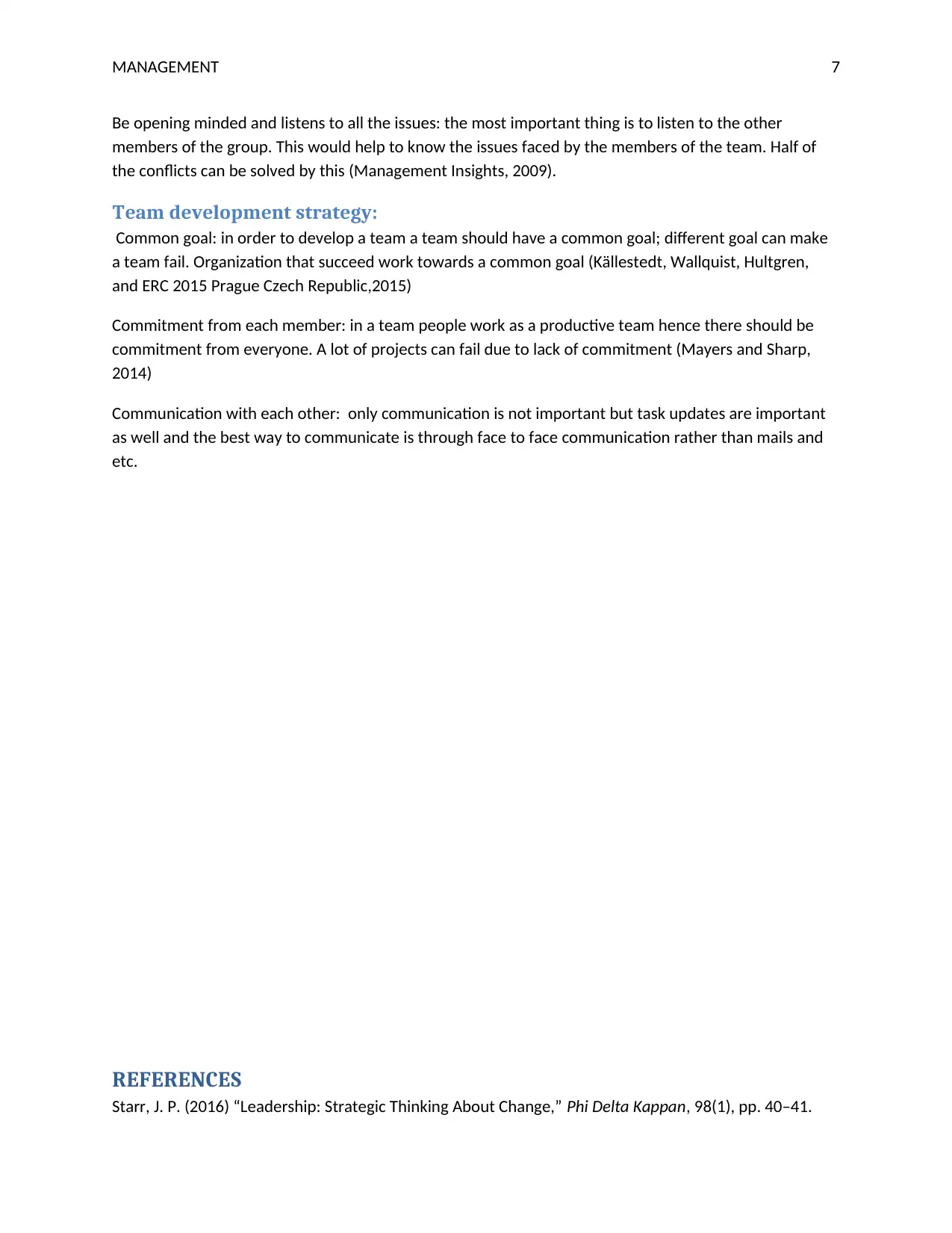
MANAGEMENT 7
Be opening minded and listens to all the issues: the most important thing is to listen to the other
members of the group. This would help to know the issues faced by the members of the team. Half of
the conflicts can be solved by this (Management Insights, 2009).
Team development strategy:
Common goal: in order to develop a team a team should have a common goal; different goal can make
a team fail. Organization that succeed work towards a common goal (Källestedt, Wallquist, Hultgren,
and ERC 2015 Prague Czech Republic,2015)
Commitment from each member: in a team people work as a productive team hence there should be
commitment from everyone. A lot of projects can fail due to lack of commitment (Mayers and Sharp,
2014)
Communication with each other: only communication is not important but task updates are important
as well and the best way to communicate is through face to face communication rather than mails and
etc.
REFERENCES
Starr, J. P. (2016) “Leadership: Strategic Thinking About Change,” Phi Delta Kappan, 98(1), pp. 40–41.
Be opening minded and listens to all the issues: the most important thing is to listen to the other
members of the group. This would help to know the issues faced by the members of the team. Half of
the conflicts can be solved by this (Management Insights, 2009).
Team development strategy:
Common goal: in order to develop a team a team should have a common goal; different goal can make
a team fail. Organization that succeed work towards a common goal (Källestedt, Wallquist, Hultgren,
and ERC 2015 Prague Czech Republic,2015)
Commitment from each member: in a team people work as a productive team hence there should be
commitment from everyone. A lot of projects can fail due to lack of commitment (Mayers and Sharp,
2014)
Communication with each other: only communication is not important but task updates are important
as well and the best way to communicate is through face to face communication rather than mails and
etc.
REFERENCES
Starr, J. P. (2016) “Leadership: Strategic Thinking About Change,” Phi Delta Kappan, 98(1), pp. 40–41.
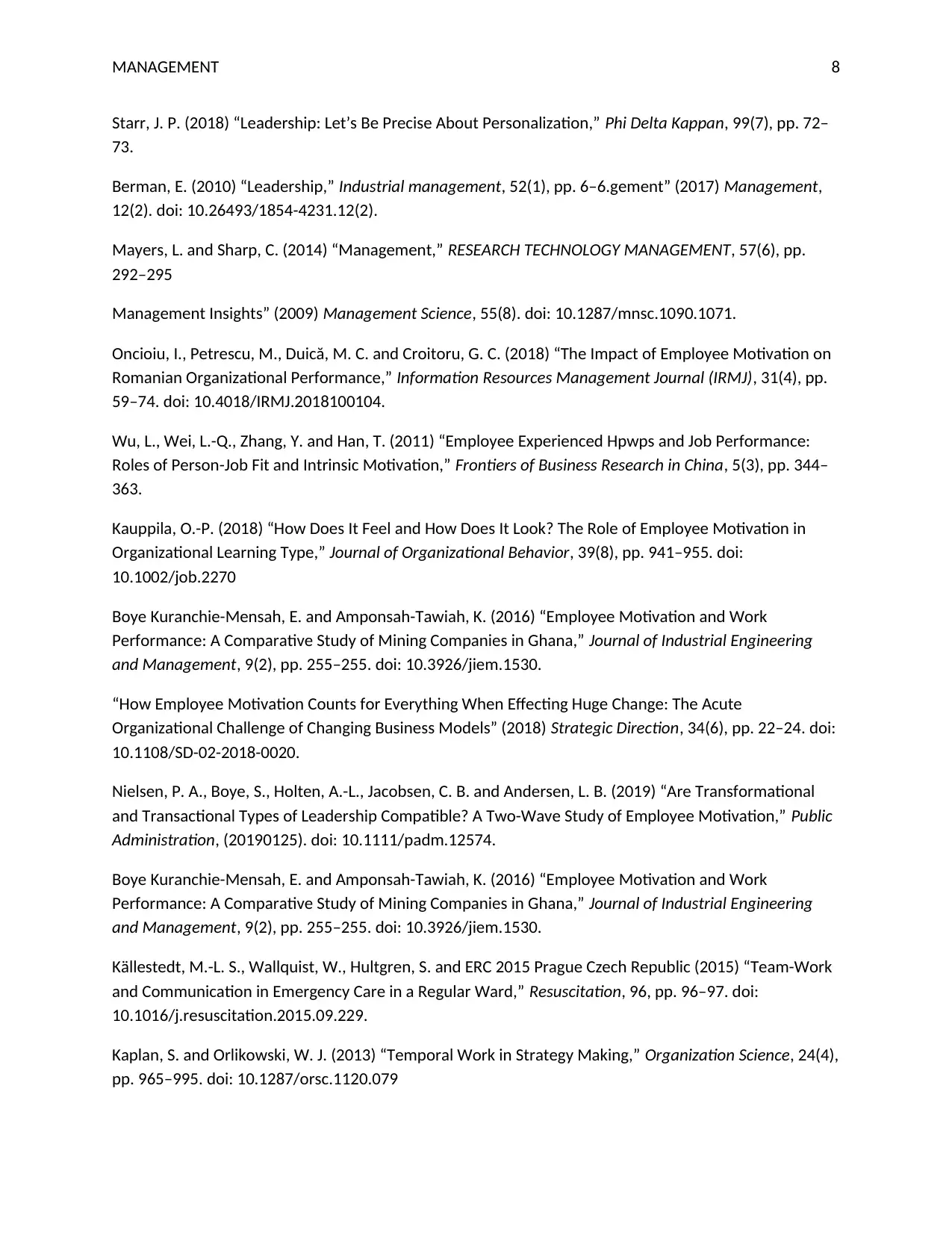
MANAGEMENT 8
Starr, J. P. (2018) “Leadership: Let’s Be Precise About Personalization,” Phi Delta Kappan, 99(7), pp. 72–
73.
Berman, E. (2010) “Leadership,” Industrial management, 52(1), pp. 6–6.gement” (2017) Management,
12(2). doi: 10.26493/1854-4231.12(2).
Mayers, L. and Sharp, C. (2014) “Management,” RESEARCH TECHNOLOGY MANAGEMENT, 57(6), pp.
292–295
Management Insights” (2009) Management Science, 55(8). doi: 10.1287/mnsc.1090.1071.
Oncioiu, I., Petrescu, M., Duică, M. C. and Croitoru, G. C. (2018) “The Impact of Employee Motivation on
Romanian Organizational Performance,” Information Resources Management Journal (IRMJ), 31(4), pp.
59–74. doi: 10.4018/IRMJ.2018100104.
Wu, L., Wei, L.-Q., Zhang, Y. and Han, T. (2011) “Employee Experienced Hpwps and Job Performance:
Roles of Person-Job Fit and Intrinsic Motivation,” Frontiers of Business Research in China, 5(3), pp. 344–
363.
Kauppila, O.-P. (2018) “How Does It Feel and How Does It Look? The Role of Employee Motivation in
Organizational Learning Type,” Journal of Organizational Behavior, 39(8), pp. 941–955. doi:
10.1002/job.2270
Boye Kuranchie-Mensah, E. and Amponsah-Tawiah, K. (2016) “Employee Motivation and Work
Performance: A Comparative Study of Mining Companies in Ghana,” Journal of Industrial Engineering
and Management, 9(2), pp. 255–255. doi: 10.3926/jiem.1530.
“How Employee Motivation Counts for Everything When Effecting Huge Change: The Acute
Organizational Challenge of Changing Business Models” (2018) Strategic Direction, 34(6), pp. 22–24. doi:
10.1108/SD-02-2018-0020.
Nielsen, P. A., Boye, S., Holten, A.-L., Jacobsen, C. B. and Andersen, L. B. (2019) “Are Transformational
and Transactional Types of Leadership Compatible? A Two-Wave Study of Employee Motivation,” Public
Administration, (20190125). doi: 10.1111/padm.12574.
Boye Kuranchie-Mensah, E. and Amponsah-Tawiah, K. (2016) “Employee Motivation and Work
Performance: A Comparative Study of Mining Companies in Ghana,” Journal of Industrial Engineering
and Management, 9(2), pp. 255–255. doi: 10.3926/jiem.1530.
Källestedt, M.-L. S., Wallquist, W., Hultgren, S. and ERC 2015 Prague Czech Republic (2015) “Team-Work
and Communication in Emergency Care in a Regular Ward,” Resuscitation, 96, pp. 96–97. doi:
10.1016/j.resuscitation.2015.09.229.
Kaplan, S. and Orlikowski, W. J. (2013) “Temporal Work in Strategy Making,” Organization Science, 24(4),
pp. 965–995. doi: 10.1287/orsc.1120.079
Starr, J. P. (2018) “Leadership: Let’s Be Precise About Personalization,” Phi Delta Kappan, 99(7), pp. 72–
73.
Berman, E. (2010) “Leadership,” Industrial management, 52(1), pp. 6–6.gement” (2017) Management,
12(2). doi: 10.26493/1854-4231.12(2).
Mayers, L. and Sharp, C. (2014) “Management,” RESEARCH TECHNOLOGY MANAGEMENT, 57(6), pp.
292–295
Management Insights” (2009) Management Science, 55(8). doi: 10.1287/mnsc.1090.1071.
Oncioiu, I., Petrescu, M., Duică, M. C. and Croitoru, G. C. (2018) “The Impact of Employee Motivation on
Romanian Organizational Performance,” Information Resources Management Journal (IRMJ), 31(4), pp.
59–74. doi: 10.4018/IRMJ.2018100104.
Wu, L., Wei, L.-Q., Zhang, Y. and Han, T. (2011) “Employee Experienced Hpwps and Job Performance:
Roles of Person-Job Fit and Intrinsic Motivation,” Frontiers of Business Research in China, 5(3), pp. 344–
363.
Kauppila, O.-P. (2018) “How Does It Feel and How Does It Look? The Role of Employee Motivation in
Organizational Learning Type,” Journal of Organizational Behavior, 39(8), pp. 941–955. doi:
10.1002/job.2270
Boye Kuranchie-Mensah, E. and Amponsah-Tawiah, K. (2016) “Employee Motivation and Work
Performance: A Comparative Study of Mining Companies in Ghana,” Journal of Industrial Engineering
and Management, 9(2), pp. 255–255. doi: 10.3926/jiem.1530.
“How Employee Motivation Counts for Everything When Effecting Huge Change: The Acute
Organizational Challenge of Changing Business Models” (2018) Strategic Direction, 34(6), pp. 22–24. doi:
10.1108/SD-02-2018-0020.
Nielsen, P. A., Boye, S., Holten, A.-L., Jacobsen, C. B. and Andersen, L. B. (2019) “Are Transformational
and Transactional Types of Leadership Compatible? A Two-Wave Study of Employee Motivation,” Public
Administration, (20190125). doi: 10.1111/padm.12574.
Boye Kuranchie-Mensah, E. and Amponsah-Tawiah, K. (2016) “Employee Motivation and Work
Performance: A Comparative Study of Mining Companies in Ghana,” Journal of Industrial Engineering
and Management, 9(2), pp. 255–255. doi: 10.3926/jiem.1530.
Källestedt, M.-L. S., Wallquist, W., Hultgren, S. and ERC 2015 Prague Czech Republic (2015) “Team-Work
and Communication in Emergency Care in a Regular Ward,” Resuscitation, 96, pp. 96–97. doi:
10.1016/j.resuscitation.2015.09.229.
Kaplan, S. and Orlikowski, W. J. (2013) “Temporal Work in Strategy Making,” Organization Science, 24(4),
pp. 965–995. doi: 10.1287/orsc.1120.079
⊘ This is a preview!⊘
Do you want full access?
Subscribe today to unlock all pages.

Trusted by 1+ million students worldwide

MANAGEMENT 9
1 out of 10
Related Documents
Your All-in-One AI-Powered Toolkit for Academic Success.
+13062052269
info@desklib.com
Available 24*7 on WhatsApp / Email
![[object Object]](/_next/static/media/star-bottom.7253800d.svg)
Unlock your academic potential
Copyright © 2020–2025 A2Z Services. All Rights Reserved. Developed and managed by ZUCOL.





